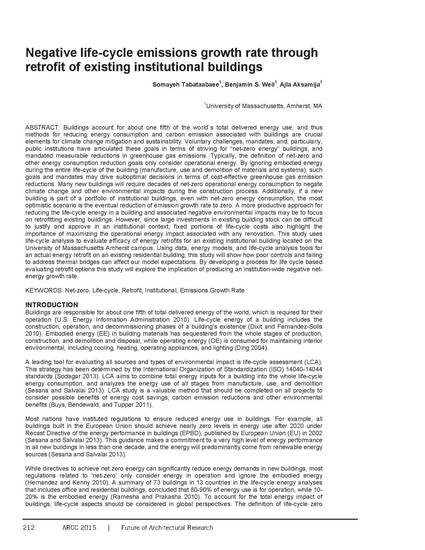
Article
Negative Life-Cycle Emissions Growth Rate Through Retrofit of Existing Institutional Buildings
Proceedings of the Architectural Research Centers Consortium (ARCC) 2015 Conference
(2015)
Abstract
Buildings account for about one fifth of the world`s total delivered energy use, and thus methods for reducing energy consumption and carbon emission associated with buildings are crucial elements for climate change mitigation and sustainability. Voluntary challenges, mandates, and, particularly, public institutions have articulated these goals in terms of striving for “net-zero energy” buildings, and mandated measurable reductions in greenhouse gas emissions. Typically, the definition of net-zero and other energy consumption reduction goals only consider operational energy. By ignoring embodied energy during the entire life-cycle of the building (manufacture, use and demolition of materials and systems), such goals and mandates may drive suboptimal decisions in terms of cost-effective greenhouse gas emission reductions. Many new buildings will require decades of net-zero operational energy consumption to negate climate change and other environmental impacts during the construction process. Additionally, if a new building is part of a portfolio of institutional buildings, even with net-zero energy consumption, the most optimistic scenario is the eventual reduction of emission growth rate to zero. A more productive approach for reducing the life-cycle energy in a building and associated negative environmental impacts may be to focus on retrofitting existing buildings. However, since large investments in existing building stock can be difficult to justify and approve in an institutional context, fixed portions of life-cycle costs also highlight the importance of maximizing the operational energy impact associated with any renovation. This study uses life-cycle analysis to evaluate efficacy of energy retrofits for an existing institutional building located on the University of Massachusetts Amherst campus. Using data, energy models, and life-cycle analysis tools for an actual energy retrofit on an existing residential building, this study will show how poor controls and failing to address thermal bridges can affect our model expectations. By developing a process for life cycle based evaluating retrofit options this study will explore the implication of producing an institution-wide negative net-energy growth rate.
Keywords
- net-zero,
- life-cycle,
- retrofit,
- institutional,
- emissions growth rate
Disciplines
Publication Date
2015
Citation Information
Somayeh Tabataabaee, Benjamin Weil and Ajla Aksamija. "Negative Life-Cycle Emissions Growth Rate Through Retrofit of Existing Institutional Buildings" Proceedings of the Architectural Research Centers Consortium (ARCC) 2015 Conference (2015) Available at: http://works.bepress.com/ajla_aksamija/85/
